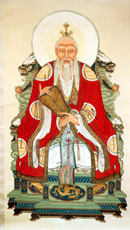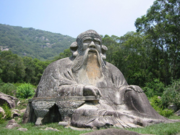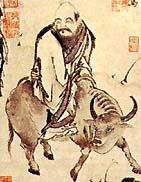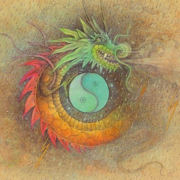Laozi
2008/9 Schools Wikipedia Selection. Related subjects: Philosophers
| Eastern philosophy Ancient philosophy |
|
 Laozi, depicted as the Taoist god. |
|
| Full name | Laozi Lao Tzu Lao Tse Laotze Lao Zi |
|---|---|
| Birth | fl. 4th century BC |
| School/tradition | Taoism |
| Notable ideas | Wu wei |
|
Influenced
|
|
| This article contains Chinese text. Without proper rendering support, you may see question marks, boxes, or other symbols instead of Chinese characters. |
Laozi (Chinese: 老 子; pinyin: Lǎozǐ; Wade-Giles: Lao tzu; also Lao Tse, Laotze, Lao Zi, Lão Tử, and other variations) was a philosopher of ancient China and is a central figure in Taoism (also spelled "Daoism"). Laozi literally means "Old Master" and is generally considered an honorific. Laozi is revered as a god in religious forms of Taoism. Taishang Laojun is a title for Laozi in the Taoist religion, which refers to him as "One of the Three Pure Ones".
According to Chinese tradition, Laozi lived in the 6th century BC. Historians variously contend that Laozi is a synthesis of multiple historical figures, that he is a mythical figure, or that he actually lived in the 4th century BC, concurrent with the Hundred Schools of Thought and Warring States Period. Laozi was credited with writing the central daoist work the Daodejing (Tao Te Ching), which was originally known simply as the Laozi.
A central figure in Chinese culture, both nobility and common people claim Laozi in their lineage. Zhuangzi, widely considered the intellectual and spiritual successor of Laozi, had a notable impact on Chinese literature, culture and spirituality. Throughout history, Laozi's work was embraced by various anti-authoritarian movements.
Historicity of Laozi
Laozi is traditionally regarded as the author of the Daodejing (Tao Te Ching), though its authorship has been debated throughout history.
The earliest reliable reference (circa 100 BC) to Laozi is found in the Records of the Grand Historian ( Shiji) by Chinese historian Sima Qian (ca. 145–86 BC), which combines three stories. In the first, Laozi was said to be a contemporary of Confucius (551-479 BC). His surname was Li (李 "plum"), and his personal name was Er (耳 "ear") or Dan (聃 "long ear"). He was an official in the imperial archives, and wrote a book in two parts before departing to the West. In the second, Laozi was Lao Laizi (老來子 "Old Come Master"), also a contemporary of Confucius, who wrote a book in 15 parts. In the third, Laozi was the Grand Historian and astrologer Lao Dan (老聃 "Old Long-ears"), who lived during the reign (384-362 BC) of Duke Xian (獻公) of Qin).
Popular legends say that he was conceived when his mother gazed upon a falling star, stayed in the womb for sixty-two years, and was born when his mother leaned against a plum tree. He accordingly emerged a grown man with a full grey beard and long earlobes, which are a symbol of wisdom and long life.. In other versions he was reborn in some thirteen incarnations since the days of Fuxi; in his last incarnation as Laozi he lived to nine hundred and ninety years, and traveled to India to reveal the Dao.
According to popular traditional biographies, he worked as the Keeper of the Archives for the royal court of Chou. This reportedly allowed him broad access to the works of the Yellow Emperor and other classics of the time. The stories relate that Laozi never opened a formal school, but he nonetheless attracted a large number of students and loyal disciples. There are numerous variations of a story depicting Confucius consulting Laozi about rituals.
Many of the popular accounts say that Laozi married and had a son named Zong, who became a celebrated soldier. A large number of people trace their lineage back to Laozi, as the Tang Dynasty did. According to Simpkins & Simpkins, many (if not all) of the lineages may be inaccurate. However, they are a testament to the impact of Laozi on Chinese culture.
Traditional accounts state that Laozi grew weary of the moral decay of city life and noted the kingdom's decline. According to these legends, he ventured west to live as a hermit in the unsettled frontier at the age of 160. At the western gate of the city, or kingdom, he was recognized by a guard. The sentry asked the old master to produce a record of his wisdom. This is the legendary origin of the Daodejing. In some versions of the tale, the sentry is so touched by the work that he leaves with Laozi to never be seen again. Some legends elaborate further that the "Old Master" was the teacher of the Buddha, or the Buddha himself.
By the mid-twentieth century, a consensus had emerged among scholars that the historicity of Laozi was doubtful or unprovable, and that the Daodejing was "a compilation of Taoist sayings by many hands originating in the -4th century." Alan Watts (1975) held that this view was part of an academic fashion for skepticism about historical spiritual and religious figures, arguing that not enough would be known for years, or possibly ever, to make a firm judgment.
Names
Laozi is an honorific title. Lao means "venerable" or "old". Zi, or tzu, means "master". Zi was used in ancient China like a social prefix, indicating "Master", or "Sir". In popular biographies, Laozi's given name was Er, his surname was Li (forming Li Er, 李 耳) and his courtesy name was Boyang. Dan is a posthumous name given to Laozi, and he is sometimes referred to as Li Dan ( 李 聃).
During the Tang Dynasty, he was honoured as an ancestor of the dynasty after Daoists drew a connection between the dynasty's family name of Li and Laozi's bearing of the same name. He was granted the title Taishang xuanyuan huangdi, meaning "Supreme Mysterious and Primordial Emperor". Xuanyuan and Huangdi are also, respectively, the personal and proper names of the Yellow Emperor.
Daodejing
Laozi's magnum opus, the Daodejing, is one of the most significant treatises in Chinese cosmogony. As with most other ancient Chinese philosophers, Laozi often explains his ideas by way of paradox, analogy, appropriation of ancient sayings, repetition, symmetry, rhyme, and rhythm.
The Daodejing, often called simply the Laozi after its reputed author, describes the Dao (or Tao) as the mystical source and ideal of all existence: it is unseen, but not transcendent, immensely powerful yet supremely humble, being the root of all things. According to the Daodejing, humans have no special place within the Dao, being just one of its many ("ten thousand") manifestations. People have desires and free will (and thus are able to alter their own nature). Many act "unnaturally", upsetting the natural balance of the Dao. The Daodejing intends to lead students to a "return" to their natural state, in harmony with Dao. Language and conventional wisdom are critically assessed. Taoism views them as inherently biased and artificial, widely using paradoxes to sharpen the point.
Livia Kohn provides an example of how Laozi encouraged a change in approach, or return to "nature", rather than action. Technology may bring about a false sense of progress. The answer provided by Laozi is not the rejection of technology, but instead seeking the calm state of wu wei, free from desires. This relates to many statements by Laozi encouraging rulers to keep their people in "ignorance", or "simple-minded". Some scholars insist this explanation ignores the religious context, and others question it as an apologetic of the philosophical coherence of the text. It is not unusual political advice if Laozi literally intended to tell rulers to keep their people ignorant. However, some terms in the text, such as "valley spirit" (gushen) and "soul" (po), bear a religious context and cannot be easily reconciled with a purely ethical reading of the work.
Wu wei, literally "non-action" or "not acting", is a central concept of the Daodejing. The concept of wu wei is very complex and reflected in the words' multiple meanings, even in English translation; it can mean "not doing anything", "not forcing", "not acting" in the theatrical sense, "creating nothingness", "acting spontaneously", and "flowing with the moment."
It is a concept used to explain ziran, or harmony with the Dao. It includes the concepts that value distinctions are ideological and seeing ambition of all sorts as originating from the same source. Laozi used the term broadly with simplicity and humility as key virtues, often in contrast to selfish action. On a political level, it means avoiding such circumstances as war, harsh laws and heavy taxes. Some Taoists see a connection between wu wei and esoteric practices, such as the "sitting in oblivion" (emptying the mind of bodily awareness and thought) found in the Zhuangzi.
According to esoteric adherents, the book contains specific instructions for Daoist adepts relating to qigong meditations, and in veiled preachings the way to revert to the primordial state. This interpretation supports the view that Taoism is a religion addressing the quest of immortality.
Daoism
Laozi is traditionally regarded as the founder of Daoism, intimately connected with the Daodejing and "primordial" (or "original") Daoism. Popular ("religious") Daoism typically presents the Jade Emperor as the official head deity. Intellectual ("elite") Daoists, such as the Celestial Masters sect, usually present Laozi (Laojun, "Lord Lao") and the Three Pure Ones at the top of the pantheon of deities.
The story of Laozi has taken on strong religious overtones since the Han dynasty. As Daoism took root, Laozi was recognized as a god. Belief in the revelation of the Dao from the divine Laozi resulted in the formation of the Way of the Celestial Master, the first organized religious Daoist sect. In later mature Daoist tradition, Laozi came to be seen as a personification of Dao. He is said to have undergone numerous "transformations", or taken on various guises in various incarnations throughout history to initiate the faithful in the Way. Religious Daoism often holds that the "Old Master" did not disappear after writing the Daodejing, but rather traveled to India to reveal the Dao.
Yinxi
Laozi's relationship with the guardian of the western pass, named Yinxi (Wade Giles Yin Hsi), is the subject of numerous legends. It is Yinxi who asked Laozi to write down his wisdom in the traditional account of the Daodejing's creation. The story of Laozi transmitting the Daodejing to Yinxi is part of a broader theme involving Laozi the deity delivering salvific truth to a suffering humanity. Regardless, the deliverance of the Daodejing was the ultimate purpose of his human incarnation. Folklore developed around Laozi and Yinxi to demonstrate the ideal interaction of Taoist master and disciple.
A seventh century work, Sandong zhunang ("Pearly Bag of the Three Caverns"), provides one account of their relationship. Laozi pretended to be a farmer when reaching the western gate, but was recognized by Yinxi, who asked to be taught by the great master. Laozi was not satisfied by simply being noticed by the guard and demanded an explanation. Yinxi expressed his deep desire to find the Tao and explained that his long study of astrology allowed him to recognize Laozi's approach. Yinxi was accepted by Laozi as a disciple. This is considered an exemplary interaction between Daoist master and disciple, reflecting the testing a seeker must undergo before being accepted. A would-be adherent is expected to prove his determination and talent, clearly expressing his wishes and showing that he had made progress on his own towards realizing the Tao.
The Pearly Bag of the Three Caverns continues the parallel of an adherent's quest. Yinxi received his ordination When Laozi transmitted the Daodejing, along with other texts and precepts, just as Taoist adherents receive a number of methods, teachings and scriptures at ordination. This is only an initial ordination and Yinxi still needed an additional period to perfect his faith, thus Laozi gave him three years to perfect his Dao. Yinxi gave himself over to a full-time devotional life. After the appointed time, Yinxi again demonstrates determination and perfect trust, sending out a black sheep to market as the agreed sign. He eventually meets again with Laozi, who announces that Yinxi's immortal name is listed in the heavens and calls down a heavenly procession to clothe Yinxi in the garb of immortals. The story continues that Laozi bestowed a number of titles upon Yinxi and took him on a journey throughout the universe, even into the nine heavens. After this fantastic journey, the two sages set out to western lands of the barbarians. The training period, reuniting and travels represent the attainment of the highest religious rank in medieval Taoism called "Preceptor of the Three Caverns". In this legend, Laozi is the perfect Daoist master and Yinxi is the ideal Taoist student. Laozi is presented as the Tao personified, giving his teaching to humanity for their salvation. Yinxi follows the formal sequence of preparation, testing, training and attainment.
Influence

Potential officials throughout Chinese history drew on the authority of non-Confucian sages, especially Laozi and Zhuangzi, to deny serving any ruler at any time. Zhuangzi, Laozi's most famous follower, had a great deal of influence on Chinese literati and culture. Zhuangzi is a central authority regarding eremitism, a particular variation of monasticism sacrificing social aspects for religious aspects of life. Zhuangzi considered eremitism the highest ideal, if properly understood.
Scholars such as Aat Vervoom have postulated that Zhuangzi advocated a hermit immersed in society. This view of eremitism holds that seclusion is hiding anonymously in society. To a Zhuangzi hermit, being unknown and drifting freely is a state of mind. This reading is based on the "inner chapters" of the self-titled Zhuangzi.
Scholars such as James Bellamy hold that this could be true and has been interpreted similarly at various points in Chinese history. However, the "outer chapters" of Zhuangzi have historically played a pivotal role in the advocacy of reclusion. While some scholars state that Laozi was the central figure of Han Dynasty eremitism, historical texts do not seem to support that position.
Political theorists influenced by Laozi have advocated humility in leadership and a restrained approach to statecraft, either for ethical and pacifist reasons, or for tactical ends. In a different context, various anti-authoritarian movements have embraced the Laozi teachings on the power of the weak.
The economist Murray N. Rothbard suggests that Laozi was the first libertarian, likening Laozi's ideas on government to F.A. Hayek's theory of spontaneous order. Similarly, the Cato Institute's David Boaz includes passages from the Daodejing in his 1997 book The Libertarian Reader. Philosopher Roderick Long, however, argues that libertarian themes in Taoist thought are actually borrowed from earlier Confucian writers.

